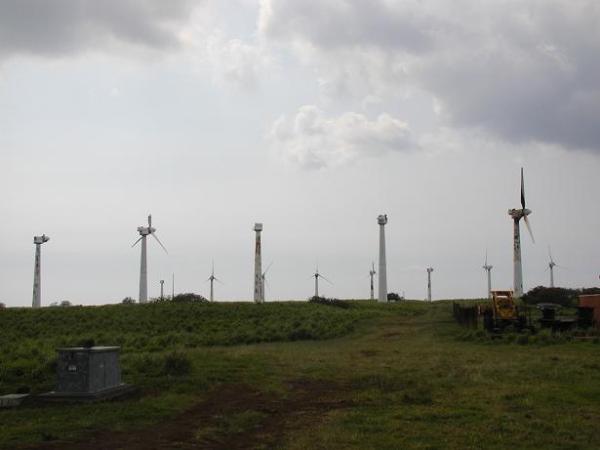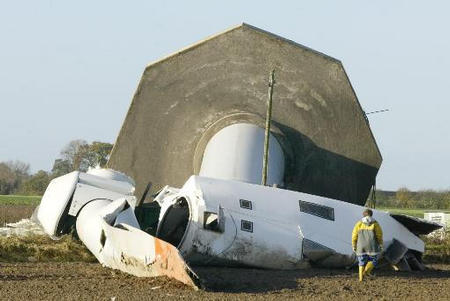As many know, I was on a road trip for two weeks. On my return into California, I traveled a road I had done many many times – California Highway 58 through Tehachapi pass, one of the windiest areas of California, and loaded with wind turbines like you see in this photo from www.wind-works.org which seems to be taken during 2003. All the turbines seem to be spinning.
![eroszondoffice[1]](http://wattsupwiththat.files.wordpress.com/2011/03/eroszondoffice1.jpg?w=640) But, the reality I encounter when I drive through there is much different than what you see in the photo above. I often drive this road, but always wished I had a video camera with me to show how many turbines are inoperable since this doesn’t show up well in still photos. Unless you have a slow shutter speed to show “blade blur”, they all look inoperable.
But, the reality I encounter when I drive through there is much different than what you see in the photo above. I often drive this road, but always wished I had a video camera with me to show how many turbines are inoperable since this doesn’t show up well in still photos. Unless you have a slow shutter speed to show “blade blur”, they all look inoperable.But this day was different. I did have a video camera with me. Plus, the day I drove through, Tuesday, March 15th, 2011 was near perfect for wind turbines. There was a front coming in, and strong winds ahead of it.
 Here’s the wind data from the ASOS at the Tehachapi airport during the time I drove through:
Here’s the wind data from the ASOS at the Tehachapi airport during the time I drove through:  The wind data displayed above are measured at 1000′ lower elevation than the wind turbines on the top of the ridge, where the wind velocity will be higher.
The wind data displayed above are measured at 1000′ lower elevation than the wind turbines on the top of the ridge, where the wind velocity will be higher.And here is what I saw of the wind turbines along the ridge top, there were quite a few inoperable on this windy day. This video was taken right about 11AM PST:
There were many more inoperable turbines, but could not be filmed from a safe vantage point along the highway. This video was take from the semi-truck staging area near the agricultural inspection station.
My best guess from the video and others I saw that I could not film is that about one in four turbines were not operating.
The problem is maintenance. The location, while perfect for wind, is treacherous for work and support equipment. Even on a flat terrain, like in Texas (shown below) where I photographed these turbines, doing maintenance on gearboxes and generators high up on a post isn’t easy.
 Imagine the complications on a mountain ridge for maintenance.
Imagine the complications on a mountain ridge for maintenance.On the wind-works.org website “tour” section, they lament the condition of the Zond (Enron) wind power sites:
Wind Plant Maintenance Items to NoteEven on the valley floor, the smaller four turbines just west of the Tehachapi airport that greet visitors who drive in from Bakersfield had a problem, and these are on flat ground and accessible:
Throughout the Tehachapi-Mojave area look for turbines without nose cones, turbines without nacelles (blown off and not replaced), oil leaking from blade-pitch seals, oil leaking from gearboxes, road cuts in steep terrain, erosion gullies, non-operating turbines, and “bone piles” of junk parts. One Zond bone pile of abandoned fiberglass blades is visible on the east side of Tehachapi-Willow Springs Rd. near Oak Creek Pass. (Kern County doesn’t permit on-ground disposal of fiberglass.) While touring wind farm sites look for blowing trash and litter (plastic bags, soft-drink cups, bottles, electrical connectors, scrap bits of metal, and so on). These all reflect management’s attention to maintenance and general housekeeping. At the better sites, you won’t see any of this.
In Palm Springs, CA, another windy place, they have similar problems:
=============================================================
Florida’s broken windmills: A California problem


The permit allowing windmills to go in didn’t say they could sit there broken. Palm Springs is getting tough. If windmills are going to exist in the city they must be operational. A city that has welcomed windmills since it was first approached about them in the early 1980′s is finding that many of those windmills are no longer working and it wants them fixed. The question is who’s responsible for fixing them? Florida Power and Light (FPL), the owner of the inoperable windmills, was allowed to install and operate local windmill farms under a conditional use permit (CUP) stipulating if the windmill does not run for six months, it’s declared a public nuisance and without a hearing, must be abated.
================================================================
Here’s a video showing the inside operations of a wind power facility in Washington State
And, the lack of maintenance problem is not just in California. In 2001, I visited Kamoa wind farm near Southpoint in the big island of Hawaii. The wind is so strong there, trees grow horizontal like this one:
![u1qwuHzJxmroka4wBmxcTa[1]](http://wattsupwiththat.files.wordpress.com/2011/03/u1qwuhzjxmroka4wbmxcta1.jpg?w=640)
As much as I was surprised by the horizontal trees, I was equally surprised to see dead wind turbines there. It was my first experience with a wind farm.
From this American Thinker article “Wind energy’s ghosts”:
=========================================================
Kamaoa Wind Farm, Hawaii. (image)
Built in 1985, at the end of the boom, Kamaoa soon suffered from lack of maintenance. In 1994, the site lease was purchased by Redwood City, CA-based Apollo Energy.===========================================================
Cannibalizing parts from the original 37 turbines, Apollo personnel kept the declining facility going with outdated equipment. But even in a place where wind-shaped trees grow sideways, maintenance issues were overwhelming. By 2004 Kamaoa accounts began to show up on a Hawaii State Department of Finance list of unclaimed properties. In 2006, transmission was finally cut off by Hawaii Electric Company.

Image from Waymarking.com
Again, like in California, Hawaii’s turbine problem is lack of maintenance.
But isn’t that the way it always has been with windmills?


It seems the more things change, the more they stay the same:

~~~~~~~~~~~~~~~~~~~~~~~~~~~~~~~~~~~~~~~~~~~~~~~~~~~~~~~~~~~~~~~
UPDATE: It appears Idaho is getting set for putting a wind power moratorium in place:
State Lawmakers Look At Wind Energy Moratorium

Mar 18, 2011 6:16 p.m.
BONNEVILLE COUNTY, Idaho — Construction of wind turbines may be coming to a halt in Idaho.
State lawmakers are considering a bill that would prevent the construction of any new wind farm for the next two years.
Over the last year, dozens of new wind turbines have gone up on east bench just outside Idaho Falls, but many of the neighbors and their legislators want to put a temporary end to new construction.
When the legislature adopted the 2007 energy plan, it did not envision so many energy companies wanting to build wind farms in Idaho.
Bill sponsor Erik Simpson said he and both his Republican and Democratic colleagues agree they need to take a look at the long-term consequences.
“Local governments need some direction as to what should be included in some of their ordinances, recognizing some of the impacts that are out there on wind, and we need to find out what those impacts might be,” said State Affairs Committee member Tom Loertcher.
To conduct the study, the bill proposes a two-year moratorium on wind farm construction.
“It may be a problem mostly in eastern Idaho now, but it’s likely to be a problem in (other legislators’) communities as well unless we take this two year pause and study this a little more in depth,” Simpson said.
Wind power is not the cheapest way to produce energy, and lawmakers want to make sure their constituents don’t have to pay top rate.
“Utility rate payers are paying more for this unreliable intermittent energy source,” Simpson said.
Many are also concerned about the environment.
“A lot of these projects are going up in pristine wildlife areas,” Simpson said.
But not everyone agrees. Some local people like Bonneville County farmer Tory Talbot want to continue to see more turbines.
“The moratorium will basically limit businesses wanting to come into Idaho. Southeastern Idaho and southern Idaho has a huge wind energy potential,” Talbot said.
The State Affairs Committee plans to continue the debate on Monday when they hear from utility companies and energy companies.
They will then vote on whether they should move the bill to the House floor.
If the bill passes, any project already approved would be allowed to move forward.
==================================================================
UPDATE2: The maintenance problem also extends to Germany:
From: jcwinnie.biz

“Gearboxes have been failing in wind turbines since the early 1990s. Barely a turbine make has escaped. The problem reached epidemic proportions with a massive series failure of gearboxes in NEG Micon machines. At the time, the NEG Micon brand was the most sold wind turbine in the world. The disaster brought the company to its knees ; It was taken over by Vestas, the world’s largest wind turbine manufacturer, which still is challenged by gearbox and rotor failures.
As previously noted, a large number of gearboxes have had to be replaced “in large numbers.” Der Spiegel reports that the German Insurance Association is none too happy…
“In addition to generators and gearboxes, rotor blades also often display defects,” a report on the technical shortcomings of wind turbines claims. The insurance companies are complaining of problems ranging from those caused by improper storage to dangerous cracks and fractures… The frail turbines coming off the assembly lines at some manufacturers threaten to damage an industry that for years has been hailed as a wild success.At Spiegel Online, Simone Kaiser and Michael relay a concern about installed wind turbines:
After the industry’s recent boom years, wind power providers and experts are now concerned. The facilities may not be as reliable and durable as producers claim. Indeed, with thousands of mishaps, breakdowns and accidents having been reported in recent years, the difficulties seem to be mounting. Gearboxes hiding inside the casings perched on top of the towering masts have short shelf lives, often crapping out before even five years is up. In some cases, fractures form along the rotors, or even in the foundation, after only limited operation. Short circuits or overheated propellers have been known to cause fires. All this despite manufacturers’ promises that the turbines would last at least 20 years.






Really informative and interesting post. I did not realize how many non-functional turbines are actually out there. In the future, I hope that wind turbine blade inspection and other testing curbs the amount of turbines that fail.
ReplyDelete